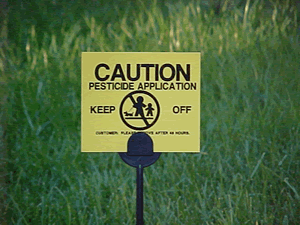
Springtime is here and we pet care professionals live for this warmer weather! The season brings budding trees, flowers and magnificent gardens, but it brings one serious potential hazard too. That is the proliferation of lawn care companies spraying millions of gallons of herbicides and pesticides on lawns across America. We’ve already been immersed in a sea of those little yellow or white lawn signs that let us know that something has been sprayed on that particular lawn. Our policy is to avoid walking near these lawns altogether, but it has become increasingly difficult to avoid them lately. If we can’t avoid them, rest assured that we keep a short leash and we don’t let your pets walk on treated lawns. These chemicals and pesticides are very toxic to our companion animals and can cause serious health issues or even lethal damage in some cases. The standard chemical used by most lawn care services to control weeds and insects is called 2,4-D. 2,4-D is a major chemical constituent used in Agent Orange. Yes, Agent Orange, the defoliant used in the Vietnam war to deprive guerrilla combatants of ground cover. When our pets walk through these treated areas they pick up the material on their paws, which can then be absorbed into their pads, or if they lie in the grass and then groom themselves they are directly ingesting the poisons into their bodies. As you know, some of our pets like to eat grass which is also another way that they directly ingest these materials. And as if that’s not bad enough, the problem doesn’t end there. When our pets pick up these chemicals they track them in to your home where you get to enjoy it too. An EPA funded study in 2001 found that chemicals used in herbicides are easily tracked indoors contaminating the air and surfaces inside our home and exposing our pets (and you) to these chemicals at levels ten times higher than pre-application levels! Keep in mind too that most of this material actually runs off into our drinking water, pollutes the waterways, kills aquatic life, poisons birds, and kills beneficial insects. If you fear that your pet has come into contact with these chemicals, you should seek immediate veterinary attention.
- Excessive salivation
- Tearing of the eyes
- Excessive urination
- Muscle twitching
- Weakness
- Difficult breathing
- Collapse
- Nausea
- Vomiting
- Abdominal pain
- Weakness
- Dizziness
- Unsteady gait
2, 4-D and other chemicals commonly used on our lawns have been linked to:
- Birth defects
- Genetic mutations
- Adverse reproductive effects
- Cancer of the liver, kidneys, and GI tract
- Lymphoma, one of the most common types of cancers in dogs
- Neurological problems
- Asthma and allergies
- Skin disorders
- Immune system problems
Greenscaping. From the U.S. Environmental Protection Agency
Greenscaping Your Lawn and Garden (PDF) Free Booklet
Introduction to Organic Lawns (PDF) Free Book
For the “non do-it-yourselfer”, there are several eco-friendly lawn care companies available today, so please choose wisely and be certain they are using healthy, organic methods and products rather than the standard poisons. Your pet and all of us will be very grateful.
